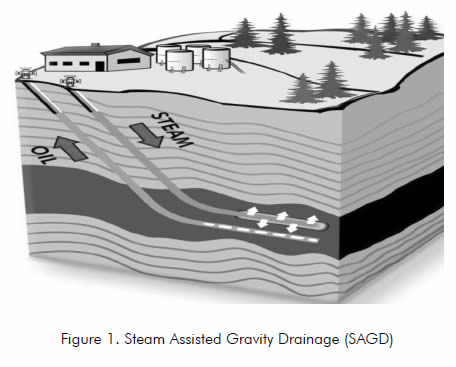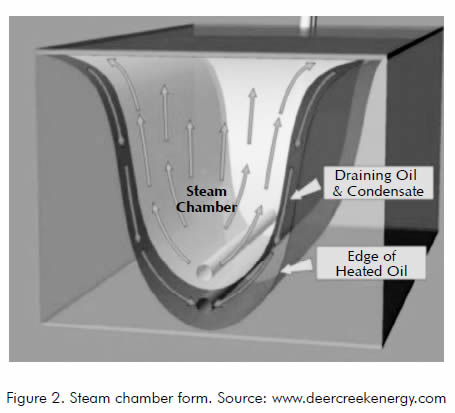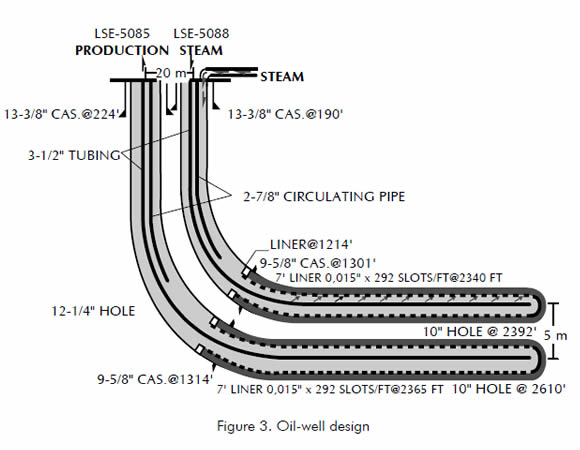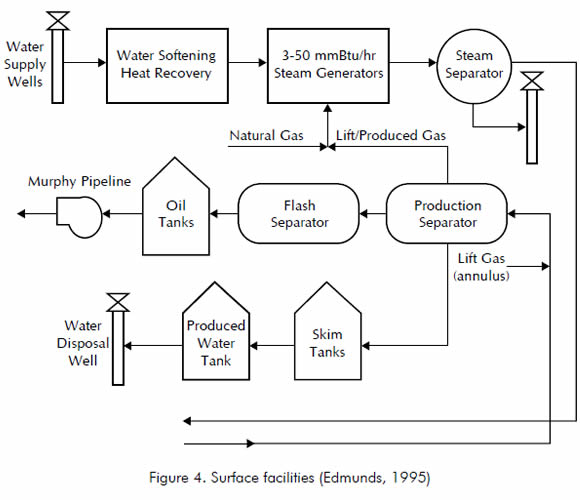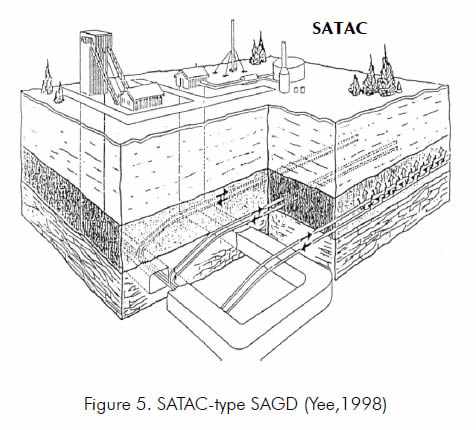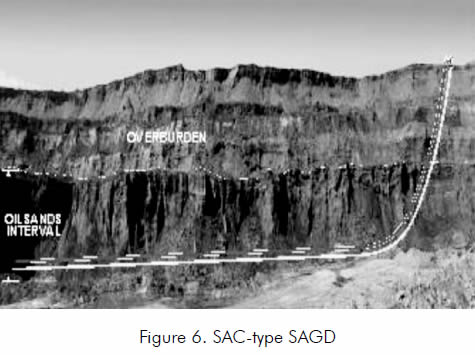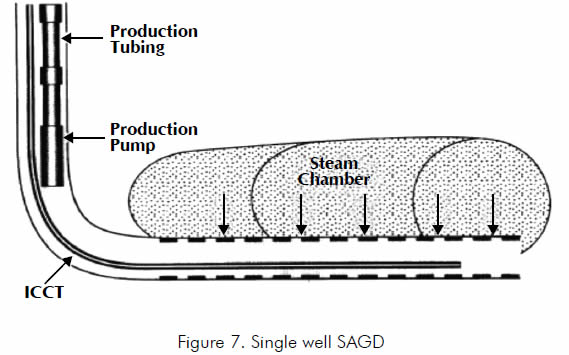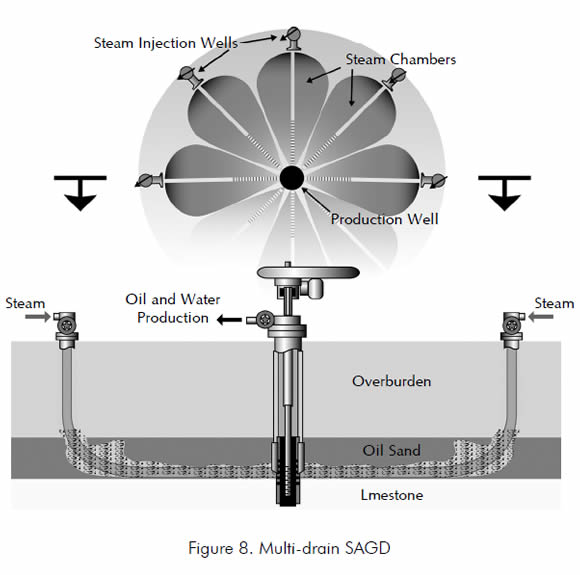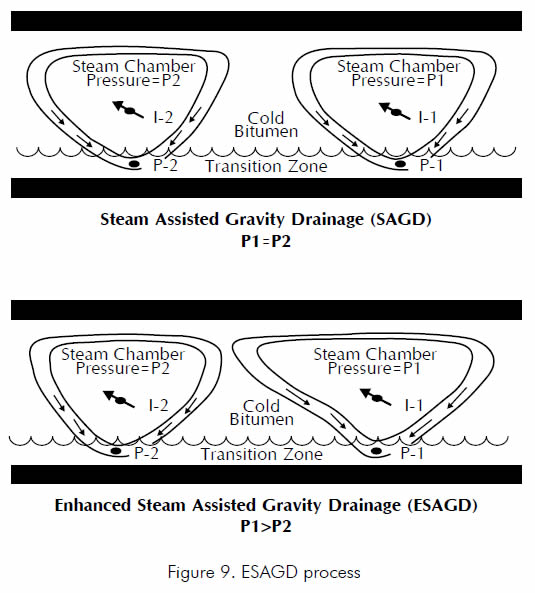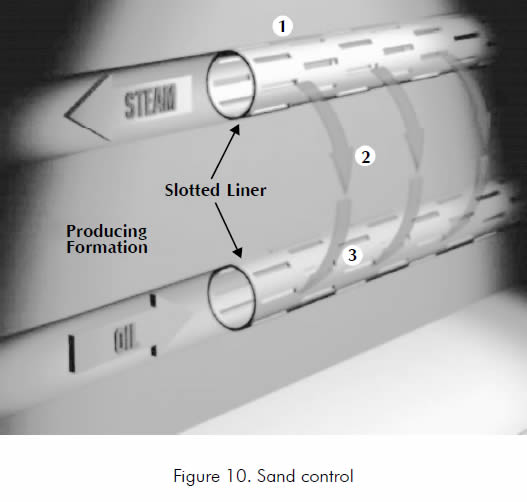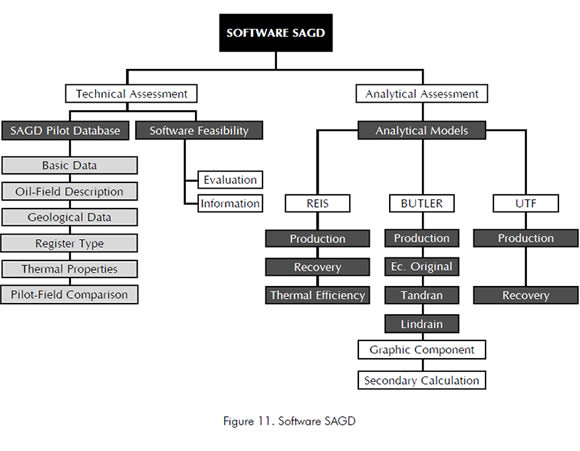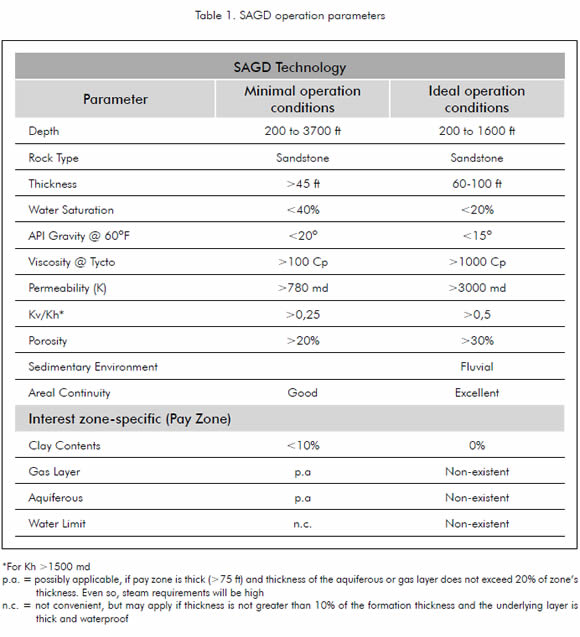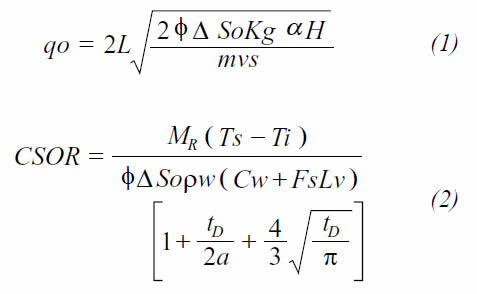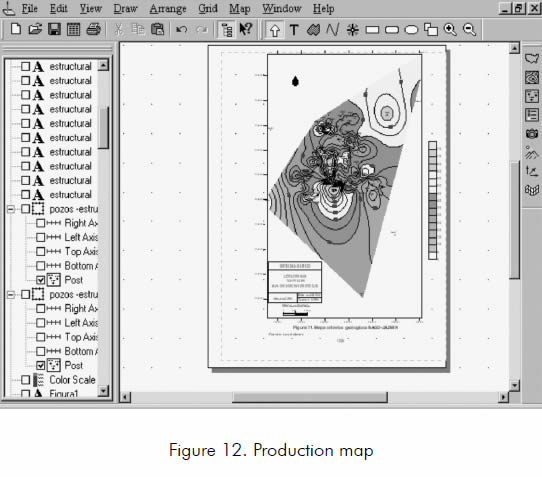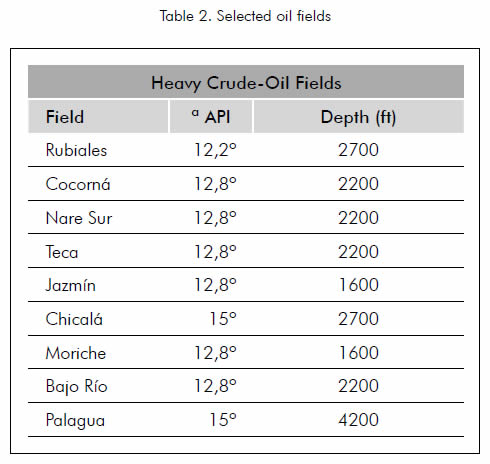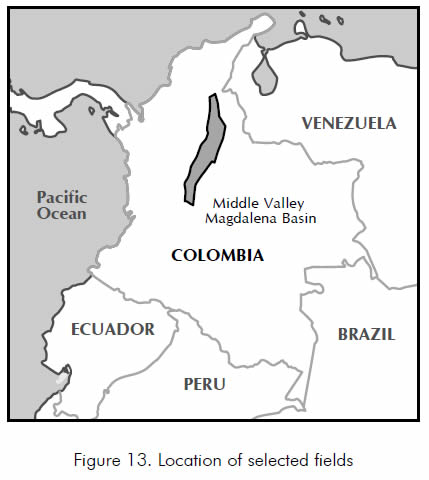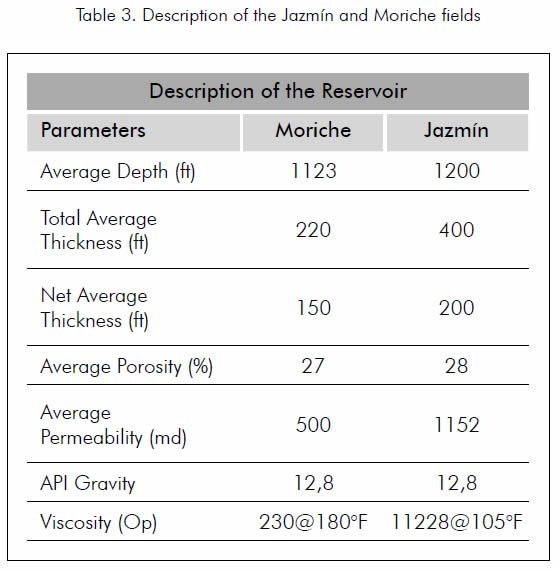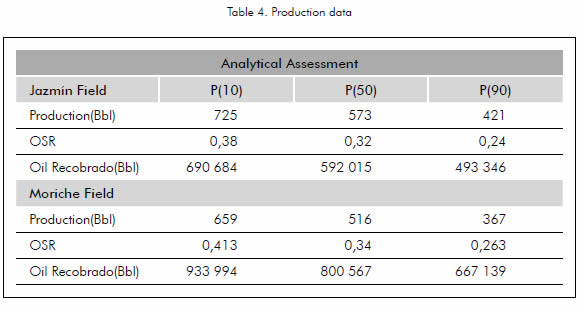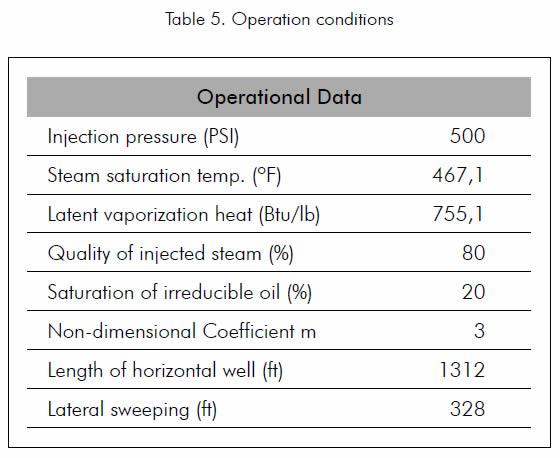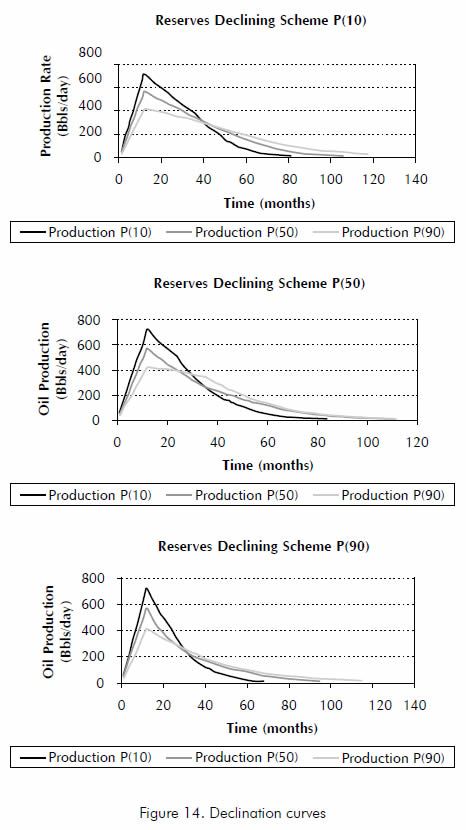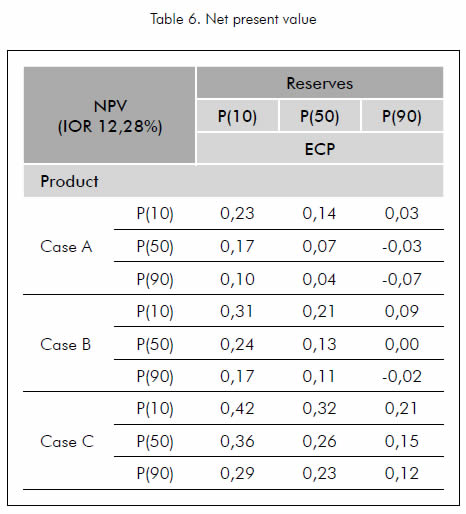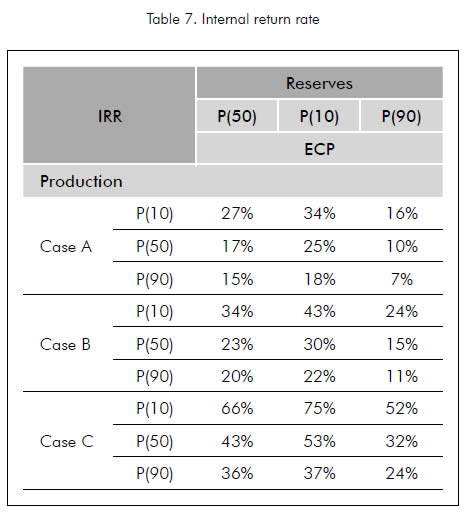Services on Demand
Journal
Article
Indicators
-
 Cited by SciELO
Cited by SciELO -
 Access statistics
Access statistics
Related links
-
 Cited by Google
Cited by Google -
 Similars in
SciELO
Similars in
SciELO -
 Similars in Google
Similars in Google
Share
CT&F - Ciencia, Tecnología y Futuro
Print version ISSN 0122-5383On-line version ISSN 2382-4581
C.T.F Cienc. Tecnol. Futuro vol.2 no.5 Bucaramanga Jan./Dec. 2004
FEASIBILITY TO APPLY THE STEAM ASSITED GRAVITY DRAINAGE (SAGD) TECHNIQUE IN THE COUNTRY'S HEAVY CRUDE-OIL FIELDS
Edwin Rodríguez*1 and Jaime Orjuela*2
1Ecopetrol S.A. - ICP Instituto Colombiano del Petróleo, A.A. 4185 Bucaramanga, Santander, Colombia
2HOCOL S.A.-Knight Bridge Petroleum Ltda., Bogotá, Colombia
e-mail: edwin.rodriguez@ecopetrol.com.co e-mail: jaime.orjuela@hocol.com.co
(Received 3 May 2004; Accepted 7 October 2004)
* To whom correspondence may be addressed
ABSTRACT
The Steam Assisted Gravity Drainage (SAGD) processes are one of the most efficient and profitable technologies for the production of heavy crude oils and oil sands. These processes involve the drilling of a couple of parallel horizontal wells, separated by a vertical distance and located near the oilfield base. The upper well is used to continuously inject steam into the zone of interest, while the lower well collects all resulting fluids (Oil, condensate and formation water) and takes them to the surface (Butler, 1994) (Figure 1).
This technology has been successfully implemented in countries such as Canada, Venezuela and United States, reaching Recovery Factors in excess of 50%.
This article provides an overview of the technique's operation mechanism and the process' most relevant characteristics, as well as the various categories this technology is divided into, including all its advantages and limitations. Furthermore, the article sets the oilfield's minimal conditions under which the SAGD process is efficient, which conditions, as integrated to a series of mathematical models, allow to make forecasts on production, thermal efficiency (OSR) and oil to be recovered, as long as it is feasible (from a technical point of view) to apply this technique to a defined oil field.
The information and concepts compiled during this research prompted the development of Software which may be used as an information, analysis and interpretation tool to predict and quantify this technology's performance. Based on the article, preliminary studies were started for the country's heavy crude-oil fields, identifying which provide the minimum conditions for the successful development of a pilot project.
Keywords: SAGD, steam injection, horizontal wells, heavy oil.
RESUMEN
Los procesos Drenaje de Gravedad con Ayuda de Vapor (SAGD) presentan una de las tecnologías más eficientes y rentables para la producción de crudos pesados y arenas petrolíferas. Estos procesos implican perforar un par de pozos horizontales paralelos, separados por una distancia vertical y situados cerca de la base del yacimiento. El pozo superior se utiliza para inyectar vapor continuamente en la zona de interés, mientras que en el pozo inferior se recogen los fluidos que salgan (petróleo, condensado y agua de la formación) y los lleva a la superficie (Butler, 1994)(Figura 1).
Esta tecnología ha sido implementada con éxito en países tales como Canadá, Venezuela y los Estados Unidos, lográndose Factores de Recuperación superiores al 50%.
Este artículo presenta una revisión de los mecanismos de operación de esta técnica y de las características más importantes del proceso, al igual que de las distintas categorías en las que se divide dicha tecnología, incluyendo todas sus ventajas y limitaciones. Más aún, este artículo fija las condiciones mínimas del yacimiento petrolero bajo las cuales el proceso SAGD se considera eficiente, cuyas condiciones, integradas a una serie de modelos matemáticos, permiten pronosticar la producción, la eficiencia térmica (OSR) y el petróleo que se va a recuperar, siempre y cuando sea posible (desde el punto de vista técnico) aplicar dicha tecnología al yacimiento.
La información y los conceptos recopilados durante esta investigación provocaron el desarrollo de un software que puede ser utilizado como herramienta de información, análisis e interpretación para pronosticar y cuantificar el desempeño de esta tecnología. Con base en el artículo, se comenzaron estudios preliminares para los yacimientos de crudo pesado del país, identificando cuáles eran las condiciones mínimas para el desarrollo exitoso de un proyecto piloto.
Palabras claves: SAGD, inyección de vapor, pozos horizontales, crudo pesado.
NOMENCLATURE
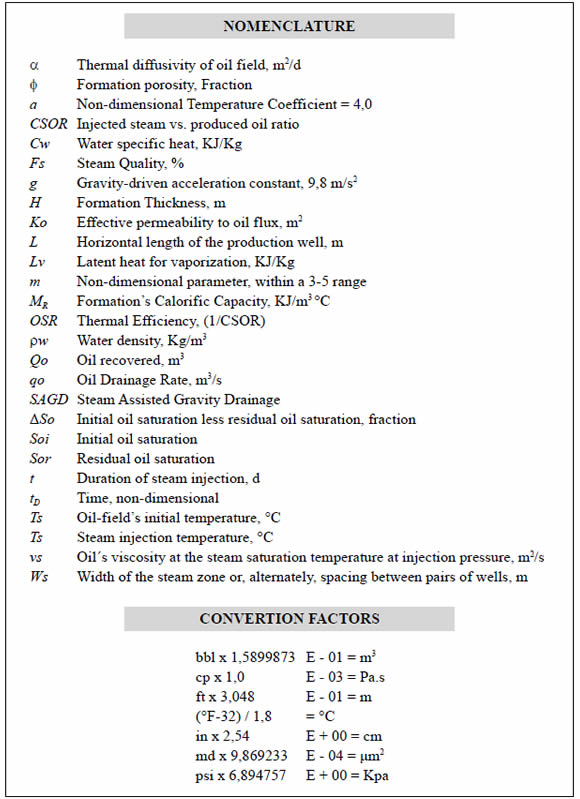
INTRODUCTION
Heavy crude-oil fields are not attractive to many companies at the time of exploitation, given the oil's high viscosity and low mobility, which prevent flowing to wells and to the surface, thus generating low recovery indexes. Colombia is no exception to the rule and this has been repeatedly seen in the country, where financial analyses showed uncompetitive figures for crude-oil production and treatment, making it unfeasible to exploit for more than a decade.
Currently, Colombia faces the challenge to convert into reserves part of the 5000 million barrels <in situ> of heavy crude-oils discovered up to date. Proven reserves of this type of crude-oil are in the range of 134 million and the current recovery is of a mere 6,0%. The great technological challenge is to increase these recovery indexes to significantly higher levels.
In the past two decades, this type of crude-oil has become more commercial, due to the implementation of thermal recovery methods, such as injection of hot fluids into the well (water and vapor) and, more recently, through the application of the SAGD. This article intends to introduce this technology which could become a very favorable alternative to increase proven reserves of heavy crude-oil in the country, to reduce the high costs of exploitation, and to increase its production, thus satisfying the demand from the Barrancabermeja and Cartagena refineries, which were build under specifications for the handling of this type of crude-oil.
Therefore, heavy crude oils will be one of the most important alternatives for the provision of oil nationwide, as reserves of light crude oil are increasingly harder to find.
SAGD CONCEPT
The SAGD is a combined mechanism of heat conduction/convection, where due to its low density, the injected fluid ascends, forming a steam chamber (Figure 2) that heats the oil, reduces its viscosity and moves it by gravity to the lower well, where it is then taken to the surface (Ali, 1997).
OPERATION MECHANISM
Two different phases are involved in SAGD processes (Saltuklaroglu, 2000).
Start-up phase
In this phase, steam is initially circulated in both wells until a caloric communication (start up phase) is established between them. This requires two strings of tubing in each well: one for injection and the other for production. If the production casing were not spacious enough to accommodate two tubing strings, an alternate process would be to inject or produce via the annular space; however, this is not advisable, since it may lead to a series of operational problems. When steam reaches breakthrough, circulation is stopped and steam is only injected to the upper well at constant pressure (just below fracture pressure, since fracturing the formation is not required to distribute steam).
In general, the start-up phase is slow and the oil production rates reached during this period are low, being directly proportional to the vertical spacing between the injecting and producing wells. It is believed that injecting a hydro-carboniferous additive (Naphta) together with steam may speed up this process.
Growing phase
From a theoretical point of view, this is the true beginning of the SAGD process: the steam chamber has reached the top of the formation and the productive well, registering the highest production rates. In this phase, it is essential to control temperatures of fluids produced, in order to prevent steam from flowing together with them; this mechanism is known as Steam Trap (Edmunds, 2000), and its function is to maintain temperatures at the well head a few degrees below steam's saturation temperature, making sure that the largest amount of injected steam remains inside the chamber.
PROCESS CHARACTERISTICS
It is important to know that:
− Pressure at steam chamber is constant.
− Steam and water condensed together with the gas in solution, plus thermal expansion, work to keep pressure around the producing well at optimal levels, avoiding any possible instability, such as coning and channeling.
− The steam chamber grows proportional to oil production; empty spaces in pores, as created by production, are filled with the steam injected to the field, thus allowing steam to fusion more immobile oil.
− Oil rate is not seriously impacted by steam injection rate.
− The maximum oil production rate usually occurs when the steam chamber reaches the top of the formation.
− First breakthrough occurs at the beginning of the horizontal section, forcing steam to heat the surrounding formation by thermal conduction, and make oil less viscous; this allows for injecting more steam, forcing it to drain the oil field, preferably at the heel of both wells.
− The main function of the Steam Trap control mechanism is to allow the formation of the steam chamber for preventing the production of live steam.
− In SAGD, the only mechanism for oil mechanism is gravitational drainage.
− The process is ineffective for vertical production wells, due to the relatively low flows that may be achieved under these conditions.
OIL-WELL DESIGN
Successful drilling of wells in the SAGD process has been possible through the use of the Magnetic Guidance Tool (MGT), (Mendoza, 1999). Under this drilling method, the first well (Lower) is drilled using conventional channeling. The MGT guides the second well (injecting) and keeps it at an ideal distance from the production well. The wells usually are completed with thermocouples and capillary tubes to monitor temperature and pressure, respectively. These wells are equipped with two strings of tubing for fluid injection and production; on top of the zone of interest, grooved, steel-coated liners are run on open hole (Saltuklaroglu, 2000)(Figure 3).
Although most projects carried out to date feature production fluids reaching the surface through the use of hot-water energy, given the depth of some fields, it is necessary to use artificial lifting methods, such as pumps and gas lift. A surface facilities diagram is shown in Figure 4.
TYPES OF SAGD
In contrast with conventional thermal methods, SAGD processes evolve constantly: each pilot program and each lab test contribute new concepts and experiences that make this technique more efficient and allow it to diversify its application to different oil fields where thermal processes are required. This has led to the patenting of new types, in terms of:
− The way of drilling oil wells.
− The way of accessing the zone of interest.
− The number of wells to be used (only one well, one pair of wells, from two to eight wells).
− Combination of vertical and horizontal wells.
− Location of wells within the field.
− The way of injecting steam, among others.
The selection of the type of SAGD to be used will be strongly based on the field's description and characteristics and on an accurate financial assessment.
Shaft and Tunnel Access (SATAC)
Named after the way in which wells are drilled and entered into the interest formation. This type involves access to the field through mining (tunnels) and underground drilling (Edmunds, 2000). From the tunnel walls, horizontal wells are drilled through the layers that underlie the zone of interest, entering horizontally into the petroliferous sands (Figure 5). This type of SAGD is mainly applied to very shallow oil fields (less than 120 m) which contain oil sands and very viscous crude-oils (more than 5 000 000 Cp).
Access and Drilling from Surface (SAC-SAGD)
This is the usual configuration (Figure 6) and, to date, most projects have been developed on it. This is an evolution of the SATAC type, and covers for the need to extend its application to deeper oil fields where mining is neither possible nor profitable. The first successful project was carried out at Canada in the Mcmurray formation, recovering > 50% OOIP within the designated pattern area and steam oil relations < 2,5.
Single Well SAGD (SW-SAGD)
In contrast with the SAC-SAGD, this type uses one single horizontal well through which it injects steam and produces oil simultaneously (Elliot, 1999; Singhal, 2000). Steam is injected at the end of the horizontal well (Toe) through an isolated concentric Coiled Tubing with numerous orifices; a portion of the injected steam and the condensed hot water returns through the annular to the well's vertical section (heel). The remaining steam, as well as in the double-SAGD, grows vertically, forming a chamber that expands toward the heel, heating the oil, lowering its viscosity and draining it down the well's annular by gravity, where it is pumped up to the surface through a second tubing string (Figure 7). This technique was specially developed to be applied in thin formations (30 ft) where it is not possible to place two horizontal wells and achieve optimal operation conditions. The SW-SAGD reduces start-up capital in half.
Multi-drain SAGD
Named after the multiple number wells involved (from 3 to 9). Out of the aforementioned configurations, this is the most recent and it is now being successfully applied at Joslyn Creek (Canada). Under this technique, several horizontal wells (from 2 to 8) are drilled and connected to a vertical central well. In contrast with the previous techniques, the horizontal wells are used to inject steam, and production is collected by the vertical well (Figure 8). Multi-drain SAGD is recommended for thin formations with good areal continuity.
This technique has the potential to significantly reduce costs, since less horizontal wells need to be drilled to drain the oil field completely.
Vertical/Horizontal wells combination
Ideally, SAGD processes are run with two parallel horizontal wells; however, there is an option to use vertical injecting wells and a horizontal production well. Vertical wells are located along the horizontal well (Kasraie, 1997), but at a lateral distance from this; in other words, the distance between the horizontal well and the vertical injecting wells on each side is of approximately 50 m . This type of configuration is applied preferably to thick formations (greater than 45 ft) with not very viscous crude oils (less than 35,000 cp) and with a gas layer.
Fast- SAGD
The Fast-SAGD principle (Polikar, 2000) is intended to produce the same amount with half the wells and 30% less steam, by implementing the conventional SAGD, plus Cyclic Steam Injection. This technique uses a horizontal auxiliary well located at the same depth of the horizontal production well, but at a certain distance from it.
The operation principle is the following: once the SAGD is set, a balancing well starts to operate, to which steam is injected at a pressure higher and greater in amount than that of the two other SAGD wells, in order to promote earlier communications between the steam chambers.
This process has been tested only at lab level and has been refined through simulation. Given its positive results, a pilot testing is soon to be started at Cold Lake, Canada.
Enhanced Steam Assisted Gravity Drainage (ESAGD)
As indicated in its name, this is an enhanced SAGD; in contrast with the SAGD types referred to above, this one does not imply drilling of additional wells or alteration of wells configuration, although it is necessary to have at least a pattern with two pairs of wells. A small pressure difference is applied between adjacent steam chambers that have been previously set under SAGD operations. This pressure differential results in the addition of a steam-thrusting component to enhance the SAGD efficiency. The pressure differential may be achieved by lowering the injecting pressure in one of the pairs, causing the steam to flow from the high-pressure chamber to the low-pressure chamber (Figure 9).
The ESAGD technique was patented by Shell and was tested at the Peace River field, in Canada, (Lorraine, 1994) with very good results. This project estimated that this thrust would increase the last recovery in 20%.
ADVANTAGES OF THE SAGD
Numerous advantages derive from using SAGD in the recovery of heavy crude oils and oil sands, as compared to conventional thermal methods. SAGD offers a series of technical, financial and environmental advantages that have made the heavy crude-oil industry more attractive and profitable.
Techniques
For the use of horizontal wells versus vertical wells:
− The drainage area is increased, allowing to reaching reserves that could not be drained in some other way.
− Better disposition and efficiency to manage thin oil formations of great lateral continuity, with gas layers, or aquifer bottom.
− Ability to carry out orthogonal fluid injection and production, resulting in greater flooding, better sweep efficiency, reduction of the steam canalization processes, reduction in number of wells required in oil-field development, better recovery rate in lesser times, minimization of blind spots, etc.
− Override elimination (Guanghul, 1995)
− Less pressure drop per length unit, which reduces water coning possibilities, minimizes damage to the well's "skin". Facilitates transportation of fluids to the surface.
As for the operation process:
− Lower injection pressure, which helps to preserve the oil field's integrity
− Greater crude-oil mobility. Once the oil contacts steam, this remains hot until drained to the production well. This is not probable in conventional steam injections, where displaced oil tends to cool on its way to production.
In regards to sand production, it can be said that when comparing SAGD processes against conventional thermal recovery methods, SAGD minimizes this issue, since it:
− Dos not require formation fracturing to achieve steam distribution; therefore, steam injecting pressures can be low.
− Since this is no steam thrust process, low fluid speeds can be managed inside the well's skin.
− Thermal efforts on the well skin are minimized by reducing heating and cooling cycles.
− From an instrumental point of view, the use of stainless-steel covered, grooved liners in both wells provide an efficient control on sand production (Figure 10).
Financial
It should be highlighted that most of the aforementioned advantages reduce costs and make processes more profitable. Other advantages include:
− Horizontal lengths ranging from 1000 to 1500 m can be drilled at three to four times the cost of a vertical well, but production achieved may be 10 times larger.
− Wells are drilled from one same location (Pad), which significantly reduces drilling costs and surface facilities.
− Depending on the depth and pressure of the oil field, most SAGD projects have not required artificial lifting methods to carry the fluid to the surface.
− Due to the absence of sand production, workover operations are not needed, reducing costs and saving time.
Environmental
The fact that a horizontal well replaces production of several vertical wells reduces the need to drill many wells to produce the oil field; likewise, these wells can be drilled from one same pad, thus generating lower ground disturbance levels, minimizing the need for facilities, and therefore generating lower environmental impact.
Disadvantages and limitations
The biggest limitation of SAGD processes is its handling of high steam quantities, particularly for thin and low-quality oil fields, where heat losses due to overburden are larger. Likewise, handling of these steam requirements needs an enormous source of fresh water, an issue that may sometimes become an obstacle. Additionally, as in most steam injection process methods, efforts are limited by oil-well depths, as imposed by steam's critical pressure.
Software SAGD
A program with high contents of reliable and detailed information on the SAGD technology, which will allow any user with knowledge on the field to understand, in an easy and didactic way, the process concept and its applications. Likewise, this is an easy-to-use tool that helps to determine the feasibility of applying such technique to a specific field and to predict its behavior through the use of analytical models that allow knowledge of oil production, thermal efficiency and recovery levels, as obtained with the process implementation.
The program was designed (Rodríguez, 2002) to integrate most of the knowledge acquired during the research and analysis process developed in this study, including:
− Field data; obtained from pilot tests and commercial-scale projects developed in other countries.
− Readings and interpretation of numerical and analytical simulation studies and lab tests which have supplied enough knowledge to understand the behavior of SAGD processes against several operation sceneries (oil-field parameters, operation conditions, etc.)
− Communications (via e-mail) with persons involved in the implementation of these processes in other countries (Canada and Venezuela). These persons have issued, in a professional way, concepts and experiences acquired during the study and development of this technology. Software is made up of a technical evaluation and an analytical evaluation, as observed in Figure 11.
Technical assessment
As developed from two different methodologies. The first methodology has a database of SAGD pilots and projects developed up to date. This database contains precise and detailed information on each one of the oil fields where the technique has been successfully implemented, allowing the program user to assess the feasibility of SAGD in specific oil fields by comparing the information provided against oil field data. In other words, if the technique is successfully executed in an oil field with identical or very similar characteristics to those of the field under study, this will become the starting point of a more detailed evaluation that may assure the process feasibility.
For the development of the second methodology, it was necessary to investigate how a series of oil field- and technique-specific issues impact or drive process development, in order establish the minimal and ideal operation conditions under which the technique proves efficient. This can be seen in Table 1.
In this methodology, the user interacts with the program when entering the oil field data to be studied. Once data is entered into the program, this will be able to determine feasibility and make a recommendation on which success/failure factors should be considered if technique is to be implemented at the field under study, and also which would be the most convenient SAGD development strategy.
Analytical assessment
Once the program user has determined feasibility of SAGD process through technical evaluation, then user can use this second tool, which will allow quantitative prediction of process behavior. The tool's design is based on mathematical and analytical models, including those by Dr. Roger Butler (1985) and Mr. John Reis (Donnelly, 1995), which allow users to predict the technique's behavior from different points of view and assumptions. Some of the equations used by the program are described below:
For production calculations
For thermal efficiency calculations
For calculation of recovered oil
Likewise, this program component is capable of performing viscosity, effective permeability, and steam saturation temperature calculations, among other. The component has an interface which allows linking to a mapping program to obtain maps of the variables discussed, and to identify those sectors of the oil field in which a better response to the technology would be achieved (Figure12).
FEASIBILITY SURVEY
A technical-financial research was performed to determine which crude-oil fields existing in the country might respond favorably to the implementation of SAGD processes. This is how 28 oil fields, mainly located in the Valle Medio del Magdalena, Llanos Orientales and Putumayo basins were analyzed. Preliminary evaluations via software concluded that processes were feasible in nine of the studied fields. Therefore a detailed study was started together with Ecopetrol S.A. and the Instituto Colombiano del Petróleo (ICP), in order to collect the information needed by the software to produce feasibility results. In this first evaluation, the critical selection factor was depth.
The selected oil fields are listed in Table 2, and most of them are located on the southwest border of the Valle Medio del Magdalena Basin, as shown in Figure 13.
Below you will find a summary (Rodríguez, 2002) of results effectively achieved
The Cocorná, Teca, Nare Sur, Bajo Río and Palagua fields do not meet minimal oil field and operation conditions under which SAGD processes may be efficiently applied. Main limitations include extreme formation heterogeneity, the poor sand quality, and poor areal continuity throughout the oil field.
In the Jazmín oil field, the application of the technique is not feasible in all its sectors, although analyzed data shows that six zones potentially may be recovered by SAGD. Out of all the studied fields, the Moriche field shows the greatest similarities with other oil fields where the technique has been successfully implemented, showing ideal operating conditions; nevertheless, the information gathered comes from only one well drilled in the field, so areal continuity in the zone of interest and homogeneity are uncertain. If unknown readings prove to be satisfactory, SAGD processes could become part of the development strategy that might open commercial feasibility for the field's exploitation.
Analysis of the Rubiales and Chicaláfields could not be performed due to lack of information available on them.
Jazmín and Moriche are contiguous fields that apparently belong to the same oil field. The geological structure is monoclinal, with a SW-NE course, dipping smoothly toward the East. Stratigraphy shows a monotonous series of intercalated sandy bodies and arcillolites. Thickness of sandy bodies ranges between 2 to 50 feet. The field's lithology is similar, although the Jazmínfield seems to show better petrophysical properties and better quality sands.
Production mechanisms at the Jazmín and Moriche fields include expansion of rock and fluid and gas in solution. There are no gas layers or bottom aquifers.
The Jazmínfield is currently in its development stage, which started at the end of year 2000 with the drilling of more than 100 directional wells from clusters.
Although the field's commercial area covers 1700 acres, the initial development stage only considered 1000 acres, which have a production of nearly 10 000 BOPD. The field has been satisfactorily developed through steam cyclic injection. The Moriche field has not started its development stage.
Production, thermal efficiency (OSR), and recovered oil data that would be generated by the implementation of a pair of SAGD wells in the best zone of the Jazmín and Moriche fields are listed in Table 4, while operation conditions under which such data was obtained are shown in Table 5.
Financial assessment (Rodríguez, 2002) was performed on the zone showing the most favorable conditions for the application of processes and the development of a pilot project at the Jazmínfield.
A total of 27 evaluation scenarios were proposed, which depend on two variables and three cases. The first variable addresses production peaks obtained from software and supported by the three mathematical models featured; the second variable is the Recovery Factor which fluctuates within a 50 - 70% range, based on data gathered at field level. Hence, we will have a production (10), a production (50) and a production (90) for production, plus another for reserves.
Declination curves were defined as per slopping schemes taken from other pilot projects worldwide (as shown in Figure 14).
Three alternate cases were proposed for the execution of the pilot project:
Case A. All conditions and parameters required to assess the technical applicability of the SAGD technique, including investments, variable costs, fixed costs, royalties, etc., will be considered.
Case B. A modification to royalty payments is included, considering that the project may be undersigned as a incremental production contract (that is, royalties go from 20% to 15%).
Case C. This case will not consider purchasing the steam generator; rather, the one already existing at the field will be adapted.
Each suggested scenario's profitability will be assessed at Net Present Value (NPV) and Internal Return Rate (IRR) levels. Results are shown in Tables 6 and 7.
CONCLUSIONS
- SAGD processes are one of the most successful technologies for the recover of heavy crude-oil and are widely applicable at different types of oil fields where thermal processes are required, as reached under ideal operation conditions recovery factors of over 50%.
- Based in the information gathered on the SAGD technique, a program was designed as an important source of knowledge and interpretation. This program, through technical and analytical assessments, lists parameters that have been considered as critical success factors and that allow to define whether Steam Assisted Gravitational Drainage processes are feasible at a certain oil field; if such were the case, the program also defines the probable production rates and thermal efficiency.
- Application of SAGD processes is technically and financially feasible in several sectors of the Jazmín oil field. These processes may also be perceived as a future strategy to accomplish commercial exploitation of the Moriche field. In all other heavy crude-oil fields nationwide, implementation of SAGD processes is not feasible, mainly due to depth and extreme heterogeneity limitations.
ACKNOWLEDGEMENTS
The authors wish to thank to Ecopetrol S.A., its manager offices for the Occidente region and its Oilfield Management, as well as the Instituto Colombiano del Petróleo (ICP), for supporting the execution of this research. Also, to Mr. H. Mendoza (PDVSA), Dr. M. Dusseault (University of Waterloo) and Dr T. Nasr, who provided information on their professional experiences with SAGD. And, to L. Rincón. Eng. (FUA) for its collaboration to the development of this project.
BIBLIOGRAPHY
Butler, R. M.,1994. "Steam assisted gravity drainage: concept, development, performance and future". J. Can. Pet. Tch., 33 (2). [ Links ]
Butler, R. M., 1985. "A new approach to the modeling of steam assisted gravity drainage". J. Can. Pet. Tch., 24 (3): 42-51. [ Links ]
Donnelly, J., 1995. "The commercial potential of steam assisted gravity drainage". SPE 30278:299, Canada. [ Links ]
Edmunds, N. R, Kovalsky, J. A., Gitins, S. D. and Peniacioli, E. D., 1992. "Review of the phase a gravity drainage test". SPE 21529, Bakersfield. [ Links ]
Edmunds, N. R., 1995. "Design of a commercial sagd heavy oil project". SPE 30277, Canada. [ Links ]
Edmunds, N. R., 2000. "Investigation of SAGD steam trap control in two and three dimensions". J. Can. Pet. Tch., 39 (1). [ Links ]
Elliot, K., 1999. "Simulation of early-time response of single-well steam assisted gravity drainage (SW-SAGD)". SPE 54618, Alaska. [ Links ]
Farouq, A., 1997. "SAGD steam assisted gravity drainage". University of Alberta, Edmonton, Canada. [ Links ]
Guanghul, Z., 1995. "Horizontal well application in a high viscous oil reservoir". SPE 30281:337, Canada. [ Links ]
Kasraie, M., 1997. "Screening and design criteria for tangleflags type reservoirs". SPE 37571:307, California. [ Links ]
Lorraine, M. A. and Goobie, 1994. "Shell/peace river horizontal well demonstration project- a test of the ESAGD process".CIM, (94) - 41, Canada. [ Links ]
Mendoza, H. and Butler, R., 1999. "SAGD, pilot test in venezuela". SPE 53687, Venezuela. [ Links ]
Polikar, M., 2000. "Fast-SAGD: half the wells and 30% less steam". SPE 65509, Canada. [ Links ]
Rodríguez, E. and Orjuela, J., 2002. "Factibilidad para aplicar la técnica de drenaje gravitacional asistido por vapor SAGD en los campos Palagua, Teca y Nare". Tesis Profesional, Universidad América, Bogotá, 236pp. [ Links ]
Saltuklaroglu, M. and Wright, G., 2000. "Mobils's SAGD experience at celtic, saskatchewan". J. Can. Pet. Tch., 39 (4), Canada. [ Links ]
Singhal, A. K., 2000. "A mechanistic study of single- well steam assisted gravity drainage". SPE 59333, Oklahoma. [ Links ]
Yee, C. T, 1998. "UTF project status update". J. Can. Pet. Tch., 38 (9), Canada. [ Links ]













